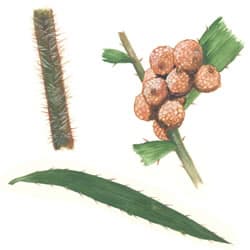Things that make you go OW!!!
Rainforests are fertile and bountiful environments brimming with food for a wide range of animals. Some plants, however, have developed defences to prevent animals from feasting too easily upon their foliage!

Stinging trees are potentially the most dangerous plant for humans in our local rainforests. The giant stinging tree – Dendrocnide excelsa is a big, fast growing tree with large round leaves that have a hairy appearance. Painful stings and even occasional deaths have resulted from people who have contacted the leaves of this tree over large areas of their body, so be wary! The shiny-leaved stinging tree is also found locally but is smaller with almost smooth stingless leaves on the mature trees. These trees are in fact related to stinging nettles but grow on a much larger and grander scale.
Another prickly rainforest plant is the lawyer cane or wait-a-while vine – Calamus muelleri. This vine is, in fact, a climbing palm that uses its spiky tendrils to assist its climb through the forest. Unfortunately, these tendrils can also grip to our clothes and skin. Thickets of lawyer cane make for an impenetrable jungle for humans but are a great place for birds to build their nests, safely out of reach of predators.
Several other spiky plants are found within the forest including the native raspberries – Rubus sp., Smilax – Smilax australis, the supplejacks – Ripogonum sp. and the native caper – Capparis velutina. Many of these plants have evolved their spikes and stings to protect their stems and leaves from grazing animals. However, we have no need to fear these heavily armed plants. Just keep to the tracks to keep safe!